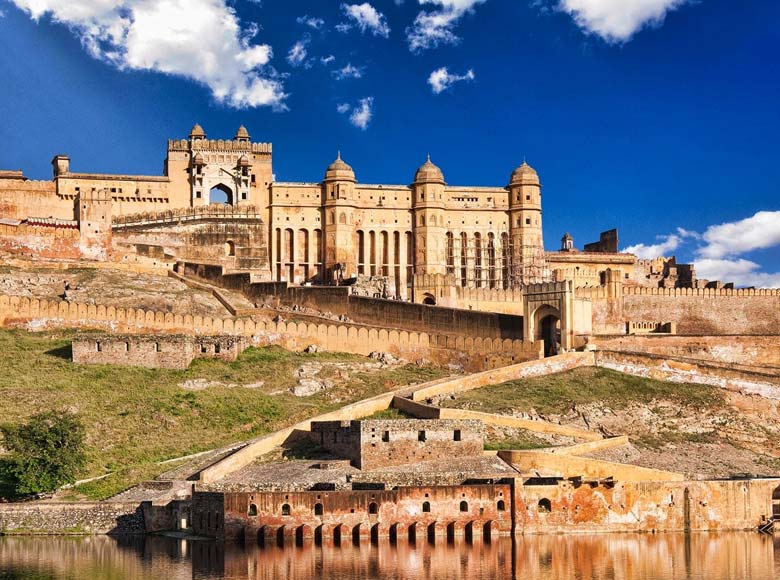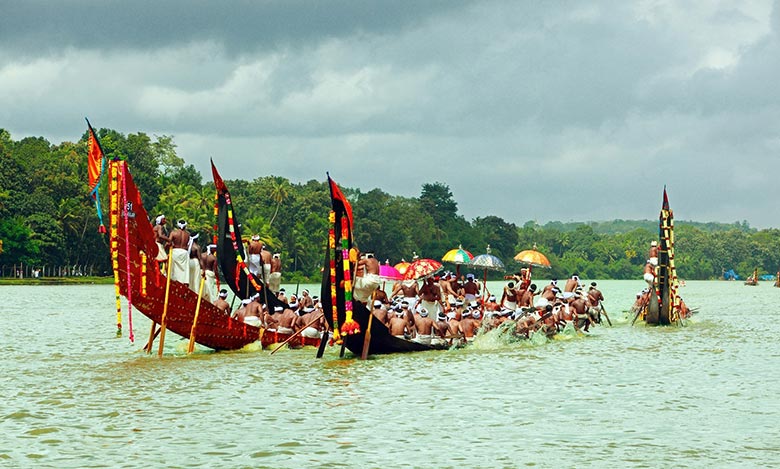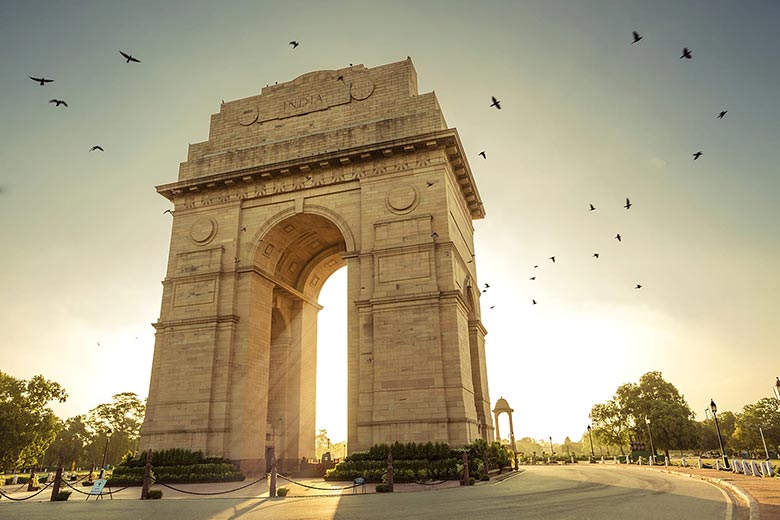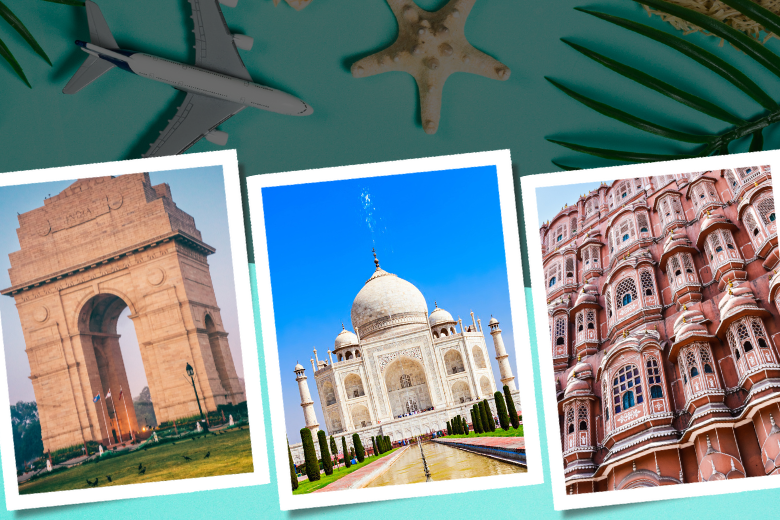Amer Fort (Hindi: अमेर किला) also known as Amber fort is a Fort situated in Amer, Rajasthan, India. Amer is a town with a location of 4 square kilometers (1.5 sq mi) located 11 kilometers (6.8 mi) from Jaipur, the capital of Rajasthan. Located high up on a hill, it is the tourist attraction destination in Jaipur. The town of Amer was originally built by Meenas, and later it was ruled by Raja Man Singh (December 21, 1550– July 6, 1614). Amer Fort is known for its imaginative Hindu design elements. With its large ramparts and collection of gates and cobbled paths, the Fort overlooks Maota Lake, which is the major source of water for the Amer Palace.
Constructed of red sandstone and marble, the appealing, luxurious place is laid out on 4 levels, each with a courtyard. It consists of the Diwan-i-Aam, or “Hall of Public Audience”, the Diwan-i-Khas, or “Hall of Private Audience”, the Sheesh Mahal (mirror palace), or Jai Mandir, and also the Sukh Niwas where a trendy environment is synthetically produced by winds that blow over a water waterfall within the royal palace.
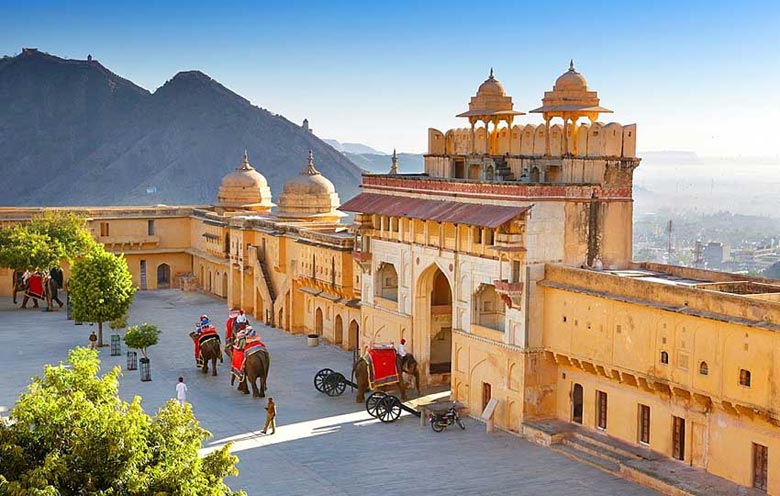
Amer Fort Jaipur
Thus, the Amer Fort is also popularly known as the Amer Palace. The palace was the residence of the Rajput Maharajas as well as their families. At the entryway to the palace near the fort’s Ganesh Gate, there is a temple dedicated to Shila Devi, a goddess of the Chaitanya cult, which was provided to Raja Man Singh when he beat the Raja of Jessore, Bengal in 1604. (Jessore is currently in Bangladesh).
This Palace, along with Jaigarh Fort, is located immediately above on the Cheel ka Teela (Hillside of Eagles) of the very same Aravalli range of hills. The palace and also Jaigarh Fort is considered one complex, as both are attached by a subterranean passage. This passage was indicated as an escape path in times of war to allow the royal family members and others in the Amer Fort to shift to the much more redoubtable Jaigarh Fort. Annual tourist visitation to the Amer Palace was reported by the Superintendent of the Department of Archaeology as well as Museums as 5000 visitors a day, with 1.4 million visitors during 2007. At the 37th session of the World Heritage Board kept in Phnom Penh, Cambodia, in 2013, Amer Fort, together with 5 various other forms of Rajasthan, was declared a UNESCO World Heritage Site as part of the group Hill Forts of Rajasthan.
Geography of Amer Fort
Amer Palace is situated on a forested hill promontory that juts into Maota Lake near the town of Amer, regarding 11 kilometers (6.8 mi) from Jaipur city, the capital of Rajasthan. The royal residence is near National Freeway 11C to Delhi. A narrow 4WD road leads up to the entrance gateway, Known as the Suraj Pol (Sun Gate) of the fort. Elephant Rides are taken through the narrow Sun Gate.
Early History of Amer Fort, Jaipur- Rajasthan
A view of the fort at Amer in Rajasthan; a watercolor by William Simpson, c.1860 The settlement at Amer was founded by Raja Alan Singh, a ruler from the Chanda clan of Meenas in 967 CE. The Amer Fort, as it stands now, was built over the remnants of this earlier structure during the reign of Raja Man Singh, the Kachwaha King of Amer. The structure was fully expanded by his descendant, Jai Singh I. Even later, Amer Fort underwent improvements and additions by successive rulers over the next 150 years, until the Kachwahas shifted their capital to Jaipur during the time of Sawai Jai Singh II, in 1727.

About Amer Fort Jaipur
Takeover of Amer Fort by Kachwahas – The very first Rajput structure was begun by Raja Kakil Dev when Amber became his capital in 1036 site of existing day Jaigarh Fort of Rajasthan. Much of Amber’s existing buildings were started or expanded during the power of Raja Man Singh I in the 1600s. Amongst the chief building is the Diwan-i-Khas in Amber Palace of Rajasthan as well as the elaborately repainted Ganesh Poll built by the Mirza Raja Jai Singh I.
The present Amer Royal Palace, was produced in the late 16th century, as a bigger royal palace to the already existing home of the rulers. The older palace, referred to as Kadimi Mahal (Persian for ancient) is known to be the oldest enduring palace in India. This ancient palace sits in the valley behind the Amer Palace.
Amer was known in the medieval duration as Dhundar (significance credited to a sacrificial mount in the western frontiers) and also ruled by the Kachwahas from the 11th century onwards– in between 1037 and also 1727 AD, till the capital was moved from Amer to Jaipur. The history of Amer is indelibly connected to these rules as they established their empire at Amer.
Most of the ancient structures of the Middle Ages period of the Meenas have actually been either destroyed or changed. Nevertheless, the 16th-century impressive towers of the Amer Fort and the palace complicated within it built by the Rajput Maharajas are extremely well maintained.

Entrance of Amer Fort Jaipur
Entrance Timing of Amer Fort – The fort is located 11 km from the city of Jaipur. The fort is opened to visitation from 9 in the morning till 6 in the evening.
Elephant ride is available from morning 9:30 till afternoon 1:00. The light show in Hindi starts from 8 in the evening and the English light show starts from 7:30 in the evening.
Suggested Read – Top 12 Excursions & Sightseeing from Udaipur, Rajasthan
Entrance Fee and Charges of Amer Fort
- Foreigner – Rs 550 per person
- Foreign Students –Rs 100 per person
- Indians –Rs 50 per person
- Indian Students – Rs 10 rupees per person
- Light Show in English – Rs 200 per person
- Light Show in Hindi – Rs 100 per person
- Elephant Ride – Rs 1100 p/person or per couple
Major Attractions Amber Fort
Major attractions of Amer are: Diwan-e-Aam, Diwan-e-Khaas, Ganesh Pol, Jaleb Chowk, Singh Pol, Jai Mandir, Yash Mandir, Sukh Mandir, Sheesh Mahal (Hall of Mirrors), Suhag Mandir, Shila Devi Holy Place, Bhool Bhulaiya, and Zanana Dyodhi.
Amer Fort palace facility mostly consists of Jaleb Chowk, Singh Pol, Diwan-e-Aam, Diwan-e-Khaas, Ganesh Pol, Yash Mandir, Sukh Mandir, Suhag Mandir, Shila Devi temple, Baradari, Bhool Bhulaiya, as well as Zanana Dyodi (ladies’ apartments). Indian Vastu could be virtually come close to if one experiences the Jaipur scenic tour. As well as the architectural excellence and fabulous stone carving work accomplished by hand at Brownish-yellow palace around 4 centuries back.
Amer Fort Elephant Ride
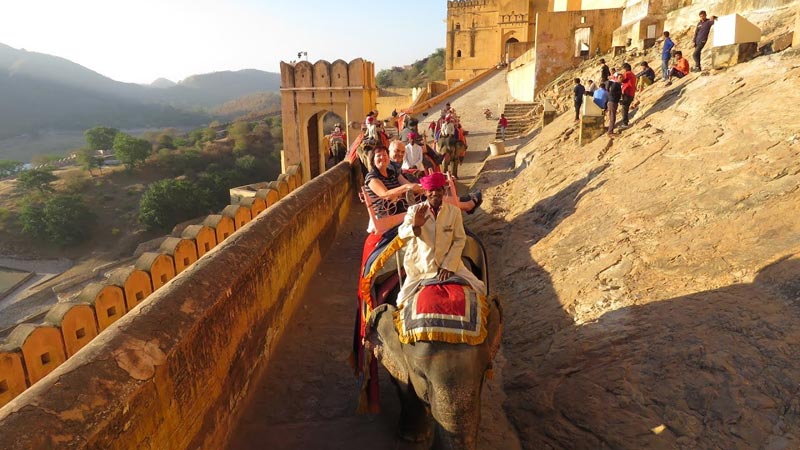
There were 2 methods to get to the Amer Fort as it is positioned on a hill. One was for elephant riding, as well as one more was walk-way which remained in the all-natural raw form of the hillside as well as rock method. Now, the walk-way is a customized fit of brand-new cemented stairs. Currently, one roadway from the bottom of the hill to Amber fort for lorries additionally has actually been constructed, however, to enjoy the journey of Amber ft, the walk-way or elephant riding is most more effective. Riding an elephant uphill appears a cliche for tourists. However, it really helps to feel the environment as well as plunging deeper in India. The elephant ride offers a horizon view of the Pink city and also a mesmerizing sight over Maotha Lake. We can pick a guide to assist, or an audio overview is also a good option which is readily available at the doorstep of the fort. Making your journey much more stunning and remarkable one, elephant safari will be the best and also it supplies a royal feeling too.
Things to do in Amer fort
- Elephant ride around the fort is an essential activity. The elephant trip finishes by mid-day. So, plan ahead.
- You can also opt for 4×4 drive tour to and fro which includes one-hour waiting time. It costs around you around 300 rupees.
- Light show at night in Amer Ft.
- Seeing the lit up fort from an all-time low of the hill at night
- Visit to the museum and garden inside the fort
- Breathtaking view from Char garden. You can view the whole city from right here.
- The classic dancing program that occurs at night in Sukh Mahal. Tickets will be available in the ticket counter.
- Appreciating a dish at Surabhi restaurant inside the fort which serves different foods
- Enjoying puppet show as well traditional songs. These are available throughout dinner time.
- Turban Museum is cost-free to enter in the fort. You can find a large collection of turbans here.
- Besides Siladevi Temple, you could locate a lot of holy places in the palace together with old havelies.
Suggested Read – Art and Crafts Tours of Rajasthan
Nearby Attractions of Amer Fort
- Anokhi Museum of Handprinting
- Jantar Mantar
- Jaigarh Fort
- Nahargarh Fort
- Hawa Mahal
- Turban Museum
10 Interesting Facts about Amber Fort and Palace
- Situated in Amber, 11 kilometers north-east of Jaipur, Amber Fort was the capital of the Kachhawa Rajputs before to Jaipur was constructed
- Amber Fort takes its name from Amba Mata, the fertility and earth goddess of the Minas
- Of all the Rajput palaces as well as forts, Amer Royal Palace is the most enchanting
- Amber Fort is mirrored in the attractive Maota Lake, making it look like a magic castle in a fairyland
- A popular attraction at the foot of the hill is an elephant ride that takes vacationers up to Amber Fort
- One of the most attractive palaces with Amber Fort is the Sheesh Mahal or the Palace of Mirrors
- A specific destination here is the “magic flower” fresco carved in marble which has seven distinct styles of fishtail, a lotus, a hooded cobra, an elephant trunk, a lion’s tail, a cob of corn and also a scorpion
- One of the most striking entrances is the two-storey Ganesh Pol enhanced with detailed paints and also fragile prison screens
- A 2-km passage attaches amber fort with Jaigarh Fort; visitors can walk through part of this tunnel
- Amber Fort could be entered on a composite ticket which permits access on the very same day to Nahargarh Ft, Jantar Mantar, and Hawa Mahal.
What is the Best Time to Visit Amer Fort in Jaipur
The best time to visit Amer Fort in Jaipur is during the cooler months of October to March. The weather is more pleasant during this time, making it ideal for exploring the fort and its surroundings. Avoid visiting during the summer months (April to June) as temperatures can soar. It is uncomfortable to explore the fort during the day. It’s also advisable to avoid the monsoon season (July to September) as the fort can get slippery and certain areas may be inaccessible due to rainfall.
Weekdays are generally less crowded than weekends. You can also try visiting early in the morning to beat the rush, especially if you’re interested in seeing the Sila Devi temple. If you are keen on the light and sound show, plan your visit for the evening (between 7 and 9 pm). This nighttime experience offers a unique perspective on the fort’s beauty.
Looking To Book Your Amer Fort OR Rajasthan Tour Package?
For more information on Rajasthan Tour Packages Contact Swan Tours, Delhi, India or 00 91 – 1123415601
